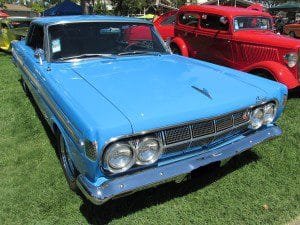A bit of automotive history tells us that the Mercury Comet was supposed to be an entry level compact Edsel. After the Edsel’s non stellar performance, the Comet was reassigned to the Mercury line. From the very first the Comet was a success with sales of more than 100,000 vehicles it’s first year. Second year sales were 185,000.

Mercury essentially had two types of automobiles for the 1964 model year. These were the full size Monterey, Montclair and Park Lanes and the compact Comet, although the 64 Comet was a bit larger than the generic compact. The Comet started to approach intermediate in size.
The Mercury Comet went through a few concept changes since it’s inception in 1960. During that year the Mercury Comet came as either a sedan or station wagon. The Comet was a relative of the Ford Falcon. Both automobiles were designed at the same time. As car collectors are aware, the Ford Falcon chassis went on to become the underpinnings of the Ford Mustang. Because of it’s relationship with the Falcon, the Comet was more compact than intermediate.

Changes to the 1964 Mercury Comet
At first the Mercury Comet was marketed as a compact and economical automobile. For the 1964 model year, the Comet model was redesigned with a sporty style. Also offered were more V-8 engine options. The 64 Mercury Comets had power. New models for 1964 were the series 202, 404, Caliente and Cyclone. The Cyclone was Comet’s performance model and replaced the previous S-22.
Body styles for 1964 included a two door coupe and convertible and a four door sedan and station wagon.

Comet Gets a Boost from Competition Successes
The performance image for the Mercury Comet was aided greatly when a fleet of Comet Caliente hardtops averaged more than 105 mph for 100,000 miles in Daytona.
Customized drag racing Comet’s with 427 cubic inch big blocks were also catching a lot of attention. After results of the endurance run were advertised, sales of the new Comets began to grow dramatically. Mercury also competed in the East African Safari to solidify it’s durability attributes. The East African Safari was known as the most demanding rally with about 3,200 miles of the worst roads in the world. The Mercury Comet didn’t win this rally but it certainly proved that it could take some of the most brutal punishment any car would ever encounter anywhere. The durability of the Mercury Comet was a given.
1964 Mercury Comet Specifications
The Mercury Comet came out in 1964 with two Inline Six engines, a 170 and 200 cubic inch, and two V-8’s. These were a 260 and 289 cubic inch design. Horsepower on the sixes were 101 and 120 respectively and for the eights, 164 and 210.
Transmission choices were a three speed automatic or a four speed manual.
Brakes were four wheel self adjusting.
Front suspension was made up of an independent ball joint and coil springs. Rear suspension were longitudinal leaf springs.

You may enjoy the related AutoMuseumOnline articles on the links below…
Dimensions included a wheelbase of 114.0 inches and an overall length of 195.1 inches. The car had a width of 71.4 inches and a height of 55.3 inches.
Mercury produced a total of 231,000 vehicles for the 1964 model year. Out of that number there were a total of 188,000 Comets built.
The Comets VIN should be found on the inside of the left fender.
Mercury Comet as Collector Cars
The Mercury Comet has a lot of history attached to it notably coming out at a time when the American automakers started to compete with compact cars. It’s also notable that the vehicle at first was intended to be a compact Edsel.

Auction and asking prices for first and second generation Comets vary of course by model and condition, mileage plus degree of restoration. In the case of the 1964 Mercury Comet, the car represented the first of the second generation Comets and had a total redesign.
You may see an asking price range running from $7,000 to $30,000. The S-22’s have some of the higher asking prices as do finely restored convertibles. The Cyclone produced in 1964 took the place of the S-22. The Comet S-22, which had been added along with the Custom models in 1963, had six bullet shaped tail lights and the regular Comets four oval lights. The 1964 Comets had six round taillights as shown in the photo above.
(Article and photos copyright 2014 AutoMuseumOnline)
